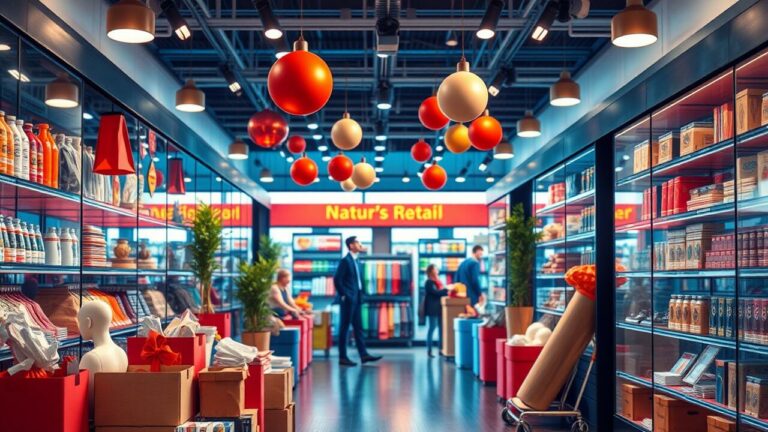How to Use Robotics in Retail
Table Of Contents
How to Use Robotics in Retail to Enhance Efficiency and Customer Experience
Key Takeaways
- Various uses of automation in the marketplace
- Different categories of retail automatons
- Advantages of incorporating automation within the marketplace
- Obstacles in adopting automation in the marketplace
- Procedures for utilizing automation in the marketplace
Applications of Robotics in Retail
The retail industry is increasingly embracing robotics to enhance operational efficiency and customer interactions. Mobile robots, equipped with advanced robotic manipulation capabilities, are utilized for tasks like stock replenishment, transforming how retailers manage inventory. Autonomous robots streamline various processes through robotic process automation, leading to significant improvements in service quality. To understand How to Use Robotics in Retail, businesses must evaluate their specific needs, ensuring the integration of robots aligns with their operational goals. These innovations not only enhance customer experience but also pave the way for the future of retail.
Enhancing Customer Experience with Retail Robots
Retailers are increasingly turning to robotics to enhance customer experience across various retail stores. These bots are designed to assist customers in a number of ways, from guiding them to product locations to providing real-time information and support. By integrating robotic process automation (RPA) into their operations, retailers can streamline interactions and create a more engaging shopping environment. Customers benefit from quicker service and more personalized assistance, making their shopping experience smoother and more enjoyable.
Retail chains are also utilizing automation to provide consistent customer service throughout their locations. Bots equipped with advanced AI can handle inquiries and offer product recommendations based on customer preferences. This not only frees up human employees to focus on more complex tasks but also ensures that every customer receives timely support. Understanding How to Use Robotics in Retail can unlock diverse opportunities for improving customer satisfaction and loyalty in an increasingly competitive market.
Streamlining Inventory Management Through Robotics
Robotics technology is revolutionizing inventory management in retail environments. Walmart stores are leveraging machines to automate their supply chains, ensuring real-time tracking and efficient stock replenishment. By utilizing robots for tasks such as counting inventory and moving items within warehouses, retailers can significantly enhance their operational processes. This automation frees up human staff to focus on customer interactions and improves the overall shopping experience.
Implementing chatbots and other robotic solutions offers a seamless way to manage inventory while maintaining accuracy. Retailers can efficiently monitor stock levels and predict demand fluctuations through data analytics, allowing for timely restocking. As automation becomes central to retail operations, understanding how to use robotics in retail will be crucial for businesses aiming to stay competitive. Embracing these technologies not only streamlines processes but also positions retailers to respond effectively to evolving consumer needs.
- Enhanced accuracy in inventory tracking
- Reduction in labor costs through automation
- Increased speed of inventory management tasks
- Improved customer service with staff focusing on engagement
- Better prediction of demand trends through data analytics
- Streamlined supply chain operations
- Ability to quickly adapt to changes in consumer behavior
Types of Retail Robots
The landscape of retail continues to evolve with the integration of robotics, particularly through intelligent automation technologies. Grocery retailers are increasingly adopting automated solutions that enhance customer experience and streamline logistics. Hardware such as autonomous mobile robots is designed for stock replenishment, ensuring shelves are always stocked with the right products, which directly impacts sales. Service robots provide valuable assistance to customers, guiding them through stores and improving their shopping experience. As retailers aim for a digital transformation, understanding How to Use Robotics in Retail becomes essential in harnessing these technologies to maximize efficiency and drive growth.
Autonomous Mobile Robots for Stock Replenishment
Retail robots equipped with AI technologies play a crucial role in stock replenishment, enhancing inventory management processes. These robots can autonomously navigate through store aisles, efficiently identifying and collecting items that need restocking. This capability allows employees to focus on providing better services to customers. By automating the replenishment process, in-store robotics not only save time but also improve the overall customer experience by ensuring shelves remain stocked with popular products.
Understanding how to use robotics in retail can significantly streamline operations. Retail robots can analyze inventory levels in real time, making it easier to monitor stock without manual checks. This integration of robotics reduces the likelihood of errors and minimizes human intervention, leading to a more efficient workflow. As retailers embrace robotics adoption to enhance customer experience, they increasingly recognize the potential for these technologies to transform traditional inventory management practices.
Service Robots for Customer Assistance
Robotic automation has become increasingly important in addressing various retail challenges. Service robots are designed to assist customers in retail environments by performing tasks such as answering queries, guiding shoppers through aisles, and facilitating checkout processes. These robots can handle multiple retail tasks simultaneously, enhancing the overall shopping experience. As retailers strive to achieve greater efficiency and customer satisfaction, the integration of these innovative solutions is transforming the retail reality.
Retail segments adopting service robots are witnessing significant improvements in customer engagement and operational efficiency. By effectively utilizing robotic manipulation, these machines can reduce human error and streamline processes within the retail industry. Understanding how to use robotics in retail goes beyond simply deploying inventory robots; it involves training staff to work alongside these technologies. As retailers navigate the complexities of modernization, harnessing the potential of service robots will be vital for future success.
| Robot Model | Functionality | Retail Segment | Deployment Year |
|---|---|---|---|
| SoftBank Robotics Pepper | Customer greeter and assistant | General Retail | 2014 |
| Simbe Robotics Tally | Inventory management | Grocery Stores | 2018 |
| Amagami Co. Multiservice Robot | Guiding shoppers and answering queries | Shopping Malls | 2020 |
| Zhongji Holding’s Xiaoyuan | Self-checkout assistance | Convenience Stores | 2019 |
Benefits of Integrating Robotics in Retail
Integrating robotics into the retail landscape offers numerous benefits that enhance both operational efficiency and customer satisfaction. Retail organizations can improve their retail customer experience by employing autonomous machines, such as a bipedal robot for customer assistance or a robotic inventory scanner for stock management. These innovations allow retail brands to optimize their retail strategies today by effectively addressing specific needs, such as how to use robotics in retail. Robot roaming throughout the store not only maintains accurate inventory levels but also engages shoppers, creating a more dynamic shopping environment. Retail businesses that leverage these technologies can achieve significant cost efficiency and reduce errors, positioning themselves competitively within the evolving retail sector.
Cost Efficiency and Labor Savings
Implementing robotics in retail spaces can significantly reduce operational costs while enhancing productivity. Several retailers have leveraged robot floor cleaners and other automated solutions to streamline daily tasks, allowing staff to focus on more value-added activities. This shift not only enhances efficiency but also transforms retail life, enabling retailers to allocate resources strategically during store planning. Retail customers benefit from a cleaner environment and improved service as robots handle routine maintenance.
The integration of robotics enables retailers to optimize labor costs by minimizing the need for manual labor in repetitive tasks. Autonomous tech companies are at the forefront of this shift, providing innovative solutions tailored to the retail context. Retail watchers have noted that by automating certain processes, retailers can achieve substantial savings, making for a more profitable operation. Understanding how to use robotics in retail effectively can lead to a competitive advantage in an increasingly automated market.
Improved Accuracy and Reduced Errors
The integration of robotics in retail significantly enhances accuracy in various in-store tasks. Trend retailers are increasingly adopting technologies like the Geek+ shelf-to-person mobile robots to facilitate autonomous inventory management. These free-moving machines efficiently navigate the shop, ensuring precise stock levels and reducing human error. Shoppers benefit from improved in-store experiences as these robots handle replenishment tasks seamlessly.
As top retailers focus on optimizing operations, the implementation of robotics reduces errors associated with manual processes. By following guidelines on how to use robotics in retail, businesses can deploy autonomous systems that minimize discrepancies in inventory tracking. This advancement not only streamlines labor but also creates a more reliable shopping environment for shoppers, allowing them to find products quickly and easily.
- Enhanced inventory tracking accuracy
- Reduction in stock discrepancies
- Improved customer satisfaction
- Streamlined labor processes
- Increased efficiency in restocking
- Real-time data updates on stock levels
- Lower costs associated with inventory management
Challenges in Implementing Robotics in Retail
Implementing robotics in retail comes with significant challenges that retailers must navigate. High initial investment costs can deter many businesses from adopting advanced automation solutions. Many stores require a careful evaluation of how to use robotics in retail that aligns with their specific goals. For instance, integrating software bots like AI-powered chatbots can enhance customer interactions, while equipment such as scrubber robots can improve store operations. However, the transition demands a well-planned strategy to ensure that retail customers today benefit from these innovations. Adapting existing staff to work alongside automation software is crucial, as it helps minimize disruptions in product displays and day-to-day activities. As retailers aim to enhance efficiency, overcoming these challenges becomes essential for success.

High Initial Investment Costs
Retailers face significant financial considerations when integrating robotics into their operations. The costs associated with deploying autonomous mobile robots, unattended bots, and advanced technologies for hand-scanning shelves can be substantial. While these innovations promise to enhance customer experience and improve store operations, initial expenditures could deter budget-conscious shoppers from investing in far-reaching automation efforts. Effective planning around store layouts and operational needs is essential to ensure a positive return on investment.
The process of optimizing store floors with robotics often requires a reallocation of resources. This includes not only the acquisition of sophisticated equipment but also potential renovations to accommodate autonomous floor care systems. Retailers must take a closer look at How to Use Robotics in Retail, analyzing both short-term expenses and long-term gains. Balancing the initial investment against the potential for improved efficiency and higher customer satisfaction is crucial for making informed decisions in a competitive landscape.
Workforce Adaptation and Training
Robotics in retail involves a significant shift in how employees interact with innovative technologies. Training staff on how to use robotics in retail is essential for ensuring they feel comfortable with devices like autonomous shelf-scanners. Well-prepared teams can leverage these technologies to enhance store maintenance and keep store shelves stocked and organized. This familiarity enables employees to focus more on creating a personalized shopping journey for customers rather than being bogged down by repetitive tasks.
Adopting automation bets can transform the dynamics within a store. Employees must be supported during this transition to maintain efficiency and morale. Training programs should address the operational aspects of robotics and emphasize the importance of these systems in maintaining attractive stores. By equipping staff with knowledge about how these devices operate in store aisles, retailers can ensure a seamless integration of robotics that benefits both the workforce and the shopping experience.
Steps on How to Use Robotics in Retail
Assessing specific retail needs is crucial in determining how to use robotics in retail effectively. Businesses should evaluate their current processes to identify areas where technology advances can enhance operational efficiency. Implementing machine learning tools and AI-powered hardware can optimize inventory management and improve consumer shopping behavior analytics. Utilizing RPA bots can streamline repetitive tasks, while collaborative warehouse work benefits from robots designed to assist in stock replenishment. Retailers must also explore the integration of e-commerce technology products to create interactive displays at consumer touchpoints, ultimately enriching the overall shopping experience. Adapting to new shopping trends will enable retailers to stay competitive in a rapidly evolving market.

Assessing Specific Retail Needs
Retailers must first evaluate their specific needs to determine how to use robotics in retail effectively. This involves identifying repetitive tasks that can be efficiently managed by an RPA bot or autonomous scrubbers. Understanding customer interaction points is crucial. For example, a lowebot can enhance the retail customer experience by guiding shoppers through aisles or providing information about product availability on shelves.
Analyzing existing chains and operational workflows allows retailers to pinpoint where robotics can add the most value. Advanced capabilities of robots help in automating mundane tasks, freeing up staff to focus on higher-level customer service efforts. By conducting a comprehensive assessment, businesses can align their robotic solutions to fit their unique operational demands while optimizing both efficiency and customer satisfaction.
Conclusion
Integrating robotics into retail systems can significantly transform the business landscape. Retailers must first learn how to use robotics in retail effectively, assessing specific needs to tailor solutions for their operations. By streamlining workflows along the supply chain, businesses can enhance efficiency and customer satisfaction. The implementation of robotics not only addresses current challenges but also opens up new opportunities for innovation and growth. Understanding how to use these technologies plays a pivotal role in staying competitive in an ever-evolving market.
FAQS
How can autonomous robotics improve the retail customer experience today?
Autonomous robotics can significantly enhance the retail customer experience by enabling retailers to achieve efficient store operations. By adopting robotics, the retail industry can address robotic manipulation problems and leverage advances from leading autonomous tech companies to cover millions of transactions seamlessly, resulting in improved customer satisfaction and operational efficiency.
What steps can retailers take to improve their operations using robotics in the retail industry today?
To improve their operations using robotics in the retail industry today, retailers can focus on robotics adoption that enhances the retail customer experience. By employing autonomous tech companies, they can streamline store operations and ensure that retail covers millions of transactions efficiently. This approach not only improves the retailcustomerexperience but also helps retailers achieve their operational goals.
What benefits can businesses expect from robotics adoption in the retail industry today?
Businesses can achieve significant advantages from robotics adoption, including enhancing the retail customer experience with improved service and efficiency. Today, retailers are leveraging autonomous tech companies to streamline operations, thereby covering millions of transactions and improving store operations significantly.
How can retailers today cover millions in sales using robotics in the retail industry?
By implementing robotics adoption, retailers can enhance their retail customer experience significantly. Autonomous tech company solutions allow retailers to optimize their operations and achieve better efficiency, ultimately helping the retail industry grow and thrive today.
How can today’s retailers leverage robotics to enhance their operational efficiency in the retail industry?
Today, retailers can achieve significant improvements in operational efficiency through robotics adoption, ultimately enhancing the retail customer experience. By integrating robotics into various processes, they can streamline inventory management, reduce labor costs, and increase accuracy, allowing retail businesses to cover millions in sales more effectively.
How can robotics adoption today help retailers achieve better customer service in the retail industry?
By implementing robotics adoption, today retailers can greatly improve the retail customer experience, allowing them to cover millions in sales within the retail industry. Robotics can streamline processes, enhance efficiency, and ultimately lead to higher customer satisfaction and retention.
How do successful retailers today utilize robotics adoption to enhance the retail customer experience and cover millions in sales within the retail industry?
Successful retailers today are leveraging robotics adoption to improve the retail customer experience by automating various processes that streamline operations, enable faster service, and offer personalized interactions. By integrating robotics into their strategy, they can not only enhance the retail customer experience but also effectively cover millions in sales within the retail industry.
How can retailers incorporate robotics to optimize their operational efficiency and improve the customer experience in the retail industry?
Retailers can incorporate robotics adoption in various ways to enhance the retail customer experience and optimize their operational efficiency. By implementing automation solutions, retail businesses can streamline processes, improve accuracy in inventory management, and ultimately help retail achieve greater sales goals while covering millions in profit. This strategic use of robotics in the retail industry not only accelerates service but also enhances overall customer satisfaction, driving loyalty and repeat business.
How does robotics adoption impact the retail customer experience and help retailers cover millions in sales within the retail industry?
Robotics adoption significantly enhances the retail customer experience by streamlining operations and personalizing service. Retailers can implement automated systems to manage inventory and customer interactions more efficiently, ultimately leading to increased sales and helping the retail industry cover millions in revenue.
How can retailers today use robotics to drive sales and enhance their customer experience in the retail industry?
Retailers can utilize robotics adoption to enhance the retail customer experience by providing faster service and reducing wait times. Additionally, effective robotics strategies can help retail cover millions in sales by streamlining operations in the retail industry, ultimately leading to increased customer satisfaction and sales growth.






